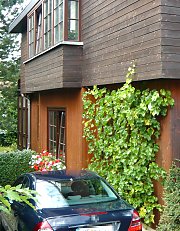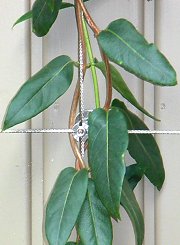Tongue and Groove Siding
Tongue and groove (interlocking) siding is one of the nine types of thin walls which FassadenGrün includes under 'special facades.' Scroll down for photo examples and a survey of 8 mounting possibilities. Note: some climbing plants can cause structural damage if the shoots climb into the gaps of the wood cladding.
Properties
Tongue-and-groove siding boards are firmly connected and behave like a single panel, which makes this type of siding particularly stable, able to absorb greater loads since the weight can be distributed easily. Boards are usually arranged horizontally; the surfaces can be slightly beveled (see below) and then resemble lap siding. If the boards are thicker than 60 mm, treat the facade as a solid wood wall. For the installation of mounts, we recommend the universal drill cartridge UB 77777.
Possibilities for the Attachment of Trellis Systems
All installation methods ('variations') are possible here, except version 07, the optimal being variation 05 (mounting into the outer wall *and* the supporting framework/underlying wood). For all other methods, the mounting points should be placed as close as possible to the substructure (rafters), as the boards are relatively susceptible to deformation when between two rafters. The connecting points between the rafters and the cladding must be reinforced with additional stainless steel screws or nails. Please also refer to the information on the respective mounts and fittings. For siding with a beveled profile, each mount needs an special VS 00005 support washer to compensate for the inclined surface.

Mounting method 06, trellis system on double-leaf formwork with insulation-- sandwich panel, rope system with wall mounts WH 10181









